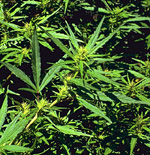 |
This small family is found in temperate Asia and North America. Hops (Humulus lupulus) and cannabis (Cannabis sativa) are cultivated, the latter probably throughout Australia, and occasionally escape from cultivation.
Characteristic features of the family Cannabaceae in Australia include: - nettle-like herb or sub-shrub, or tall climber
- leaves alternate or opposite, palmately divided or 3-lobed, gland-dotted and aromatic
- flowers small, greenish, unisexual, often with sexes on separate plants
- stamens with versatile anthers
- ovary superior, developing into a small, nutlike fruit
Description
Deciduous or semi-deciduous woody or herbaceous vines climbing by twining stems, or annual or perennial terrestrial herbs perennating by rhizomes. Stem internodes spongy, pithy or hollow. Internal secretions not obvious. Plants with simple, clavate, capitate or vesicular glandular or non-glandular, multiseriate hairs. Leaves alternate and spiral, or opposite, cauline if herbs, rarely petiolate. Stipules present, distinct and free from the petiole, scale-like, membranous or bristle-like, persistent; stipellae absent. Lamina simple or once compound, palmate, symmetric, palmatifid or palmatisect; segments filiform, acicular, subulate, linear, lanceolate or ovate; base cuneate or cordate; margins serrate, ±flat; venation palmate, with the midrib conspicuous, and the tertiary venation not reticulate; surfaces dark- or pellucid-punctate; herbaceous; distinctive odour aromatic. Male and female flowers mostly occurring on separate plants, or rarely occurring together on the same plant. Inflorescences terminal or axillary, consisting of glomerules or cymes. Bracts and bracteoles present. Pollination by wind. Flowers odourless; sessile or stalked. Floral disc absent; nectaries absent. Perianth regular, of 1 whorl only, with 5, free or fused sepaloid segments, imbricate in bud, urn-shaped, green, without contrasting markings, herbaceous, petaline or membranous. Fertile stamens 5, opposite to and free of the perianth segments, free of the ovary and style, distinct from each other, all ±equal. Anthers basifixed, versatile, opening inwards by longitudinal slits; 2-celled. Ovary superior and sessile. Carpels 2, fused; ovary with 1 locule. Style terminal, single and unbranched, or single and branched above or from the base, or absent and the stigma ±sessile on the ovary. Ovule 1, sessile; placentation apical. Fruit a dry, indehiscent achene; the perianth on the maturing fruit dry and persistent. Disseminule macro-surface featureless or with straight hairs; micro-surface ±reticulate, cream, brown or grey; conspicuously patterned, glossy or dull. Seeds 1 per fruit. Aril absent. Cotyledons 2. Embryo curved or coiled.
(Note: this description has been generated from the coded data compiled for the key. Any errors in the key data will be reflected in the descriptions.)
A treatment of the family Cannabaceae has been published in:
Flora of Australia 3: 14-15.
Australian genera of Cannabaceae (as recognised for the Flora of Australia)
* = all species introduced
*Cannabis
*Humulus

|
  |

Cannabis sativa (flowering branch)
Photo: K.Thiele © K.Thiele
|
 |
|